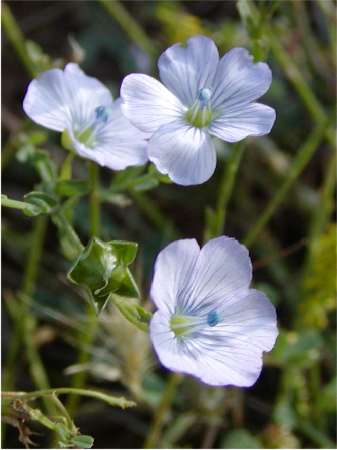Relatives
Linum bienne Mill. - Pale flax.
Taxonomic position.
Family Linaceae S.F.Gray, genus Linum L.Synonymy.
Linum angustifolium Huds., L. usitatissimum subsp. bienne (Mill.) StankeviczMorphology and biology.
Herbaceous perennial, less often biennial, (20)30-60 cm tall. Plant with numerous heavily leaved stems, which grow occasionally solitary, ascending (less often erect), branching in upper part. Stems glaucous with wax bloom, violet at the base. In addition to fertile shoots there are sterile, shortened, densely leaved decumbent stems. Leaves up to 1.5 cm long, 1 mm wide, narrow lanceolate or linear-lanceolate, acute at apex, almost pointed, glaucescent, 3-veined. Flowers solitary at branch apices, 1.1-1.6 cm diameter, homostylous. Pedicels very slender, strongly elongated after flowering. Sepals ovate, acutely carinated, white-scarious at margins, dentate-ciliate. Petals pale blue or pale violet. Fruit capsules 5-6 mm long, 4.5-5 mm diameter, globose-ovoid, dehiscent at maturity, false septa of the capsules with cilia. Seeds small, brown, smooth, shiny, 2-3 mm long, beakless. Very polymorphous species.Entomophilous. Flowers in April - May, fruits in May - June. 2n=30.
Distribution.
Mediterranean, Crimea, Caucasus (Ciscaucasia, West and East Transcaucasia, Talysh), Asia Minor.Ecology.
Mesoxerophyte. Occurs in exposed dry forests and shrubberies, dry meadows, at field fringes and in abandoned fields.Use and economic value.
Technical. Species was cultivated in Mediterranean countries in ancient times; most likely, cultivated flaxes are related to this species as their origin.References:
Brezhnev DD, Korovina ON. 1981. Wild relatives of cultivated plants of the flora of the USSR. Leningrad: Kolos. P.308-309. (In Russian).Zhukovsky PM. 1964. Cultivated plants and their relatives. Leningrad: Kolos. 501 p. (In Russian).
Yuzepchuk SV. 1949. Flax - Linum L. In: Shishkin BK, Bobrov EG, ed. 1949. Flora URSS. V.14. P.99-100. (In Russian).


